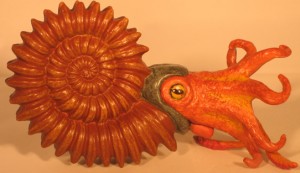Wild Safari Dinos Ammonite Replica
When it comes to teaching children about what fossils can and perhaps more importantly can’t tell us, a model of an ammonite comes in very useful. Ammonites are extinct members of the Mollusca phylum and closely related to extant (living today), cuttlefish. These invertebrates lived in chambered, coiled shells and it is these shells and their moulds that are frequently found as fossils. However, it can be difficult for the teacher to get the children to relate a fossil of a shell to the living, breathing animal.
Ammonite Replica
Wild Safari Dinos Ammonite Model

A great ammonite model for use in schools, museums and for model collectors. Picture credit: Everything Dinosaur.
Picture credit: Everything Dinosaur
What did Ammonites Actually Look Like?
This difficulty can be overcome by showing the students a model of an ammonite. Although the shells of these cephalopods are common fossils particularly in Jurassic aged strata, very few preserved soft parts of prehistoric cephalopods have been preserved. Palaeontologists believe that all ammonites lived in the outer whorl of their shells, this is referred to as the body chamber. As the ammonite got bigger it extended its tubular shell and moved its body outwards, laying down new chamber walls behind it. The earlier-formed chambers contained a mixture of water and gas which helped these marine creatures adjust their buoyancy.
“Head Foot”
The term cephalopod means “head foot”, a simple description of the body plan. A series of ten arms surrounded the mouth, two of these appendages were specialised and capable of grabbing and seizing prey. The other arms would have helped manipulate food items and pull them closer to the mouth. As these creatures are closely related to extant cephalopods they probably had complex eyes. The ammonite moved through the water by shooting jets of water out of a siphon (called the hypernome) which was positioned under the body.
Fossil Ammonites (Somerset, western England)

Have a go a lapidary this Summer? Examples of polished ammonite fossils. Picture credit: Everything Dinosaur.
Picture credit: Everything Dinosaur
The picture shows a cross section of an internal mould of an ammonite, the internal structure and the sutures (edges of the chamber wall) can be clearly seen.
There are very few ammonite replicas available, however, the fossil experts at Everything Dinosaur have a number of excellent, anatomically accurate replicas available.
To view a range of prehistoric animal models including an ammonite replica: Prehistoric Animal Replicas.
The model can be used to help explain how ammonites lived and how the shells are preserved as fossils but only very rarely are the soft parts preserved.
Helping Teachers with Extension Ideas
Extension Ideas
Key Stage 2
- Get the children to examine small ammonite fossils and compare them to the replica, what clues about the life style of the ammonite can be deduced?
- What do you think ammonites ate? Where would they fit into a food chain?
- Why did ammonites die out yet close relatives like cuttlefish and the nautilus survive? Can you encourage some independent research?
Key Stage 3
- Compare the ammonite model to pictures of extant cephalopods, what are the similarities, what are the differences?
- What theories can be proposed as to why the ammonites became extinct?
- Have the students find many different types of ammonite fossil pictures, look at the shells, why did so many different shell types evolve? What does this say about the lifestyle, environment of individual species?

